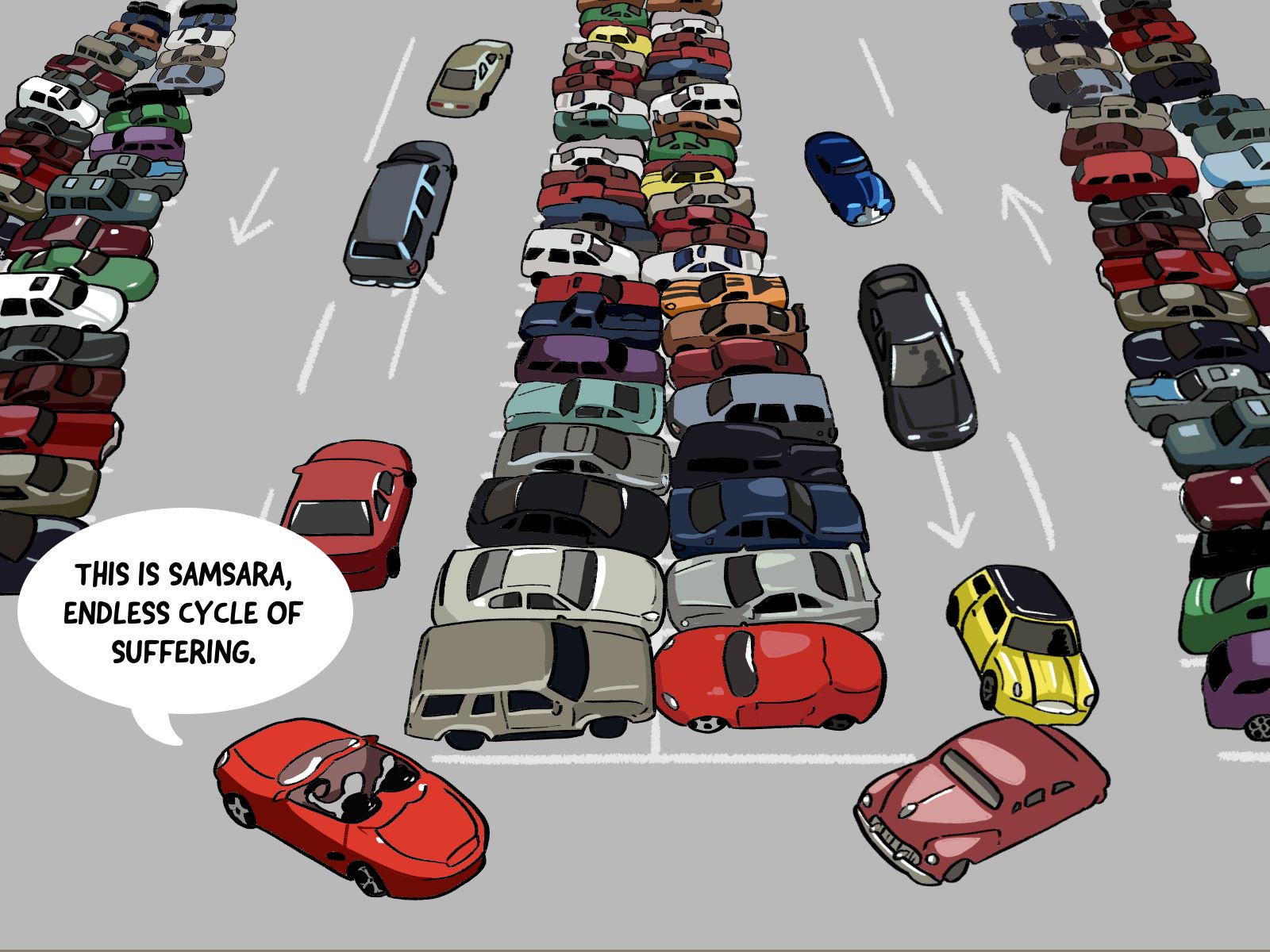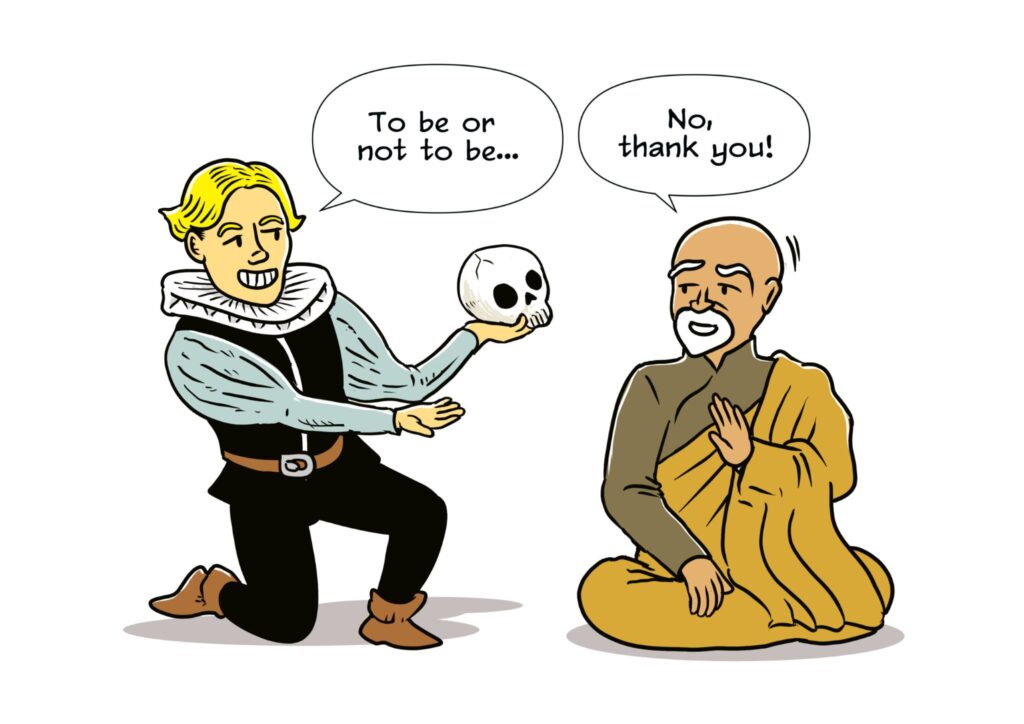
In an earlier post, the Buddha identified three specific types of craving:
- Craving for sensual pleasure.
- Craving for existence.
- Craving for non-existence.
In the most recent post, we talked about (1). In this post, we will go into detail regarding (2) and (3), the craving for existence and for non-existence.
On the day-to-day level
Craving for existence and craving for non-existence can be easily understood on a day-to-day level. Craving for existence means a desperate wanting to stay alive. It shows up commonly as the fear of death. Craving for non-existence is the opposite, which shows up as suicidal intentions, when life is so unpleasant to you want to die. Both cravings cause suffering. In a very sad way, these two are not mutually exclusive. I know that because when I was suicidal, I suffered from both simultaneously, all the time.
On the level of meditative experience
These two cravings show up on another level: in meditative experience. What most people are not aware of is the mind constantly re-constructs a subjective sense of selfness in reaction to sense stimuli and to thoughts. When the mind is sufficiently calm in meditation, there are times and circumstances where the mind is so calm it does not construct that subjective sense of selfness, so the sense of selfness fades away. For less experienced meditators, the common reaction to this experience is fear and sometimes panic. The mind clings on to the existence of this sense of selfness, and so when it seems to be disappearing, the mind is alarmed. This is craving for existence in action. There are, however, more experienced meditators with the opposite problem. These meditators become accustomed to the fading away of the subjective sense of selfness, they find that when it happens, the mind experiences serenity and joy. And then when the sense of selfness reappears, it is as if somebody disengaged the mute button on a radio and it suddenly went from silent to full volume, it feels loud and jarring. They get annoyed and wish the sense of selfness to disappear again. That is the craving for non-existence at this level.
On the cosmological level
Yet another level where these two cravings show up relates to the Buddhist worldview. In talking about the Buddhist worldview, we start venturing into the mystical side of Buddhism. Earlier, I mentioned that Buddhism is not free from having a mystical side, and if you want a full, in-depth understanding of Buddhism, you cannot avoid learning about this mystical side. However, I also mentioned that one of many genius moves by the Buddha is that the practices he formulated are so secular and universal they are effective whether or not you buy into the mystical side of things. In any case, I hope your exploration into this side of Buddhism will be as much fun for you as it was for me.
First, it turns out that, yes, there is a concept of heaven and hell in Buddhism. Actually, Buddhism is probably “greedier” than your average religion because in the Buddhist cosmology, there is not just one heaven, but 26 realms of heaven, each more refined than the previous one.[1] Thankfully, there is only one hell realm,[2] but I imagine it must be very crowded, because hey, it is hell.
The most important feature of Buddhist cosmology, in contrast to that from other religions, is the universality of impermanence. In Buddhism, all lifespans are finite, including those of the gods. On earth, all humans have finite lifespans. Some people are good, they create good karma for themselves (karma is a topic we will explore in some detail later), and after they die, they get reborn in the heavens as gods. Others are reborn either as animals, hell-beings, ghosts, or are recycled back to earth again as human beings. Whatever they are reborn as, they will have finite lifespans. Even those who are reborn as gods in the heavens have finite lifespans; some thousands or millions of years after birth, they die just like everyone else, and they get reborn based on their karma just like everyone else. It reminds me of a Buddhist joke: all gods are immortal, until they die.
In fact, even the realms themselves are impermanent. In Buddhism, there is the concept of the “world cycle”, which is the time it takes for a universe to come into being, to expand, and then to contract and disappear.[3] So even universes have life cycles and the human universe and all those heavenly realms are in different stages of that life cycle. Hence, it is not just the gods, but even heavens and universes are impermanent.
It is because of impermanence that a rebirth in heaven is not considered an ultimate solution to suffering for Buddhists. You may go to heaven, you may bliss out there for a very long time, perhaps thousands of years, perhaps millions of years. And then what? Back to square one. After the Buddha was newly enlightened, he thought of teaching the Dharma to his former teachers, Alara and Uddaka. However, they had both already passed away. In fact, due to their deep practices and impeccable karma, both of them were reborn in the highest and most refined heavenly realms. According to popular lore, the Buddha felt sad for them because they would both be there for “only” 84,000 world cycles.[4] That is a duration of 84,000 times the full lifespan of a universe, spent in a state of supremely refined bliss in the highest of heavens. And nope, even that is not good enough for a Buddhist. Told you we’re greedy.
In fact, it is said that even gods can experience real suffering. This especially happens near the end of their lifespans, when they know they are dying. Their radiance begins to fade, and other gods start avoiding them. So, they suffer an existential crisis, panic arising from impending death, and loneliness, all at once. It’s good to be a god, but it really sucks to die as one.
Given this cosmological worldview, there is an important concept in Buddhism called samsara. The word “samsara” literally means “wandering on”.[5] It signifies the repetitive cycle of birth, ageing, death and rebirth, including in the heavenly realms, the hell realm, and all the other realms that contain humans, animals and ghosts. Uninstructed, unenlightened beings just wander aimlessly in these realms from one lifetime to another to another, all the time experiencing suffering. Hence, samsara is usually described with terms such as “suffering-laden cycle of life, death, and rebirth, without beginning or end”,[6] or simply, “endless cycle of suffering”.
Once, I was at a large carpark at a retreat center. It was totally full. There was a large overflow parking lot that was mostly empty, but there was no proper signage to point drivers to it, so nobody knew it existed, hence the cars just kept literally circling the main carpark endlessly in a futile search for parking. And I told my wife, “See, that is samsara, endless cycle of suffering.”
In the context of samsara, the craving for existence is the thirst, desire, compulsion to exist, either with a form or without a form, and in doing so, to stay indefinitely within samsara, and hence to suffer endlessly. You might think, if that is the case, then the solution is to wish not to exist, and by not existing, break out of samsara. But no, that wish to not exist is the craving for non-existence, which is also a cause of suffering.
I find it illumining that the Buddha lists the craving for non-existence as one of the three cravings, because some people mistakenly think that Buddhism is a form of nihilism, and some mistakenly think the purpose of practicing Buddhism is to end up not existing. In listing the craving for non-existence as one of the three cravings, the Buddha busts both myths at once. In fact, the Buddha flatly denies that he teaches the annihilation of self.[7]
It also illuminates one other point. You see, existing and non-existing are opposites, so to have craving for both in the same list appears to put opposites on the same “list of things that are true”, it makes no sense. However, note that the commonality between the two is the word craving. That illuminates the point that neither existing nor non-existing is a cause of suffering per se, it is the craving for either or both that causes suffering. It is all about the craving. In one discourse, the Buddha describes craving for existing as “holding back” and craving for non-existing as “overreaching”.[8] To fully understand the Buddha’s teachings is to neither hold back nor overreach.
So, I guess the Buddhist answer to the age-old Shakespearean question, “To be or not to be?” is, “No, thank you.”

Activities
References
[1] “The Thirty-one Planes of Existence”, edited by Access to Insight. Access to Insight (BCBS Edition), 30 November 2013 (link). Of those 31 realms (or planes of existence), 26 are heavenly realms.
[2] Ibid. That is one way to look at it, but the texts also describe various types of hell with different names, so you can look at it either as one hell realm with different parts, or different hell realms. In any case, that distinction is not important in the context of Buddhist practice.
[3] For example, in Dīgha Nikāya 1, the Buddha talks about the contraction of one realm, the expansion of another, and the appearance of a third.
[4] Not in the canonical texts, but an illustrative lore, nonetheless.
[5] Thanissaro Bhikkhu, Samsara. Access to Insight (BCBS Edition), 2010 (link).
[6] Jeff Wilson, Saṃsāra and Rebirth. Oxford Bibliographies.
[7] Majjhima Nikāya 22.
[8] Itivuttaka 2.22.
Featured image by Natalie Tsang.

